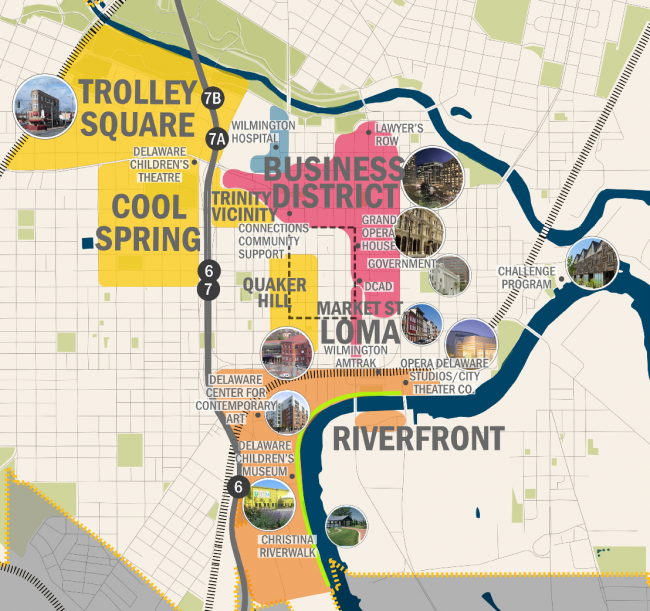The Wilmington Renaissance Corporation wants to see Wilmington succeed. That’s its mission. That’s why, earlier this year, the privately-funded nonprofit dedicated to revitalizing Wilmington, released its Creative District Plan.
The plan is separate from both the City of Wilmington and New Castle County’s business development plans, which were unveiled earlier this month. This plan, WRC Project Manager Alfred Lance said, complements the city and county plans.
WRC’s plan — which was created with the help of the Christiana Cultural Arts Center, the Interfaith Community Housing Corporation of Delaware, the Chris White Community Development Corporation and the Quaker Hill Neighborhood Association — differs from the city and county plans in that it focuses specifically on just a portion of downtown Wilmington.
“Our plan is very specific. We’re looking at the neighborhood immediately west of Market Street in Quaker Hill — 4th to 9th streets and Market to Washington,” said Carrie Gray, WRC’s managing director. “Our goal is to use creative placemaking as a strategy to support and grow the creative community that’s here in Wilmington. We want to push investment off Market and stabilize Quaker Hill.”
The WRC chose Quaker Hill as the focus, due to all of its creative and cultural assets. The neighborhood makes up much of a dense network of tech firms. Quaker Hill, Gray said, also comes with a storied history and unique architecture.
“There were a number of reasons we chose this area. We’ve always been intentional about ‘creative’ instead of ‘arts’ district,” she said. “Arts is a specific definition based in traditional — visual and performing — arts. Creative — we’re trying to be more encompassing and draw people to the neighborhood.”
The plan embraces creativity through four topics:
- Organizing: establishing district designation and management structure. The plan calls for visually distinguishing a creative district, creating vibrant public spaces and formalizing partnerships to lead the district.
- Cultivating community: promoting strong networks and social capital. Here, the plan calls for developing a marketing strategy and branding the district, attracting entrepreneurs and holding workshops to help them get started and creating ways for local artisans to create and sell their work.
- Placemaking: bring inspiration to the streets. This action plan bullet point addresses the need for promoting arts and culture events after business hours and on weekends, advocating the preservation of historical buildings and promoting affordable live/work options downtown.
- Making a space for creativity: guiding development to support creative production and consumption. Here, the plan advocates for an incubator program in the city, establishing a hub of creative production downtown and further supporting arts and culture venues.

This plan also has a tech focus, stating:
A Fab Lab combining facilities to accommodate both traditional and cutting-edge production and fabrication methods would not only serve the immediate area’s existing base of artists and makers and provide a means of entry for those looking to explore their creative potential; it would also be seen as a significant amenity to artists and creative professionals looking to relocate and would likely build a membership base drawing from those living in the greater Wilmington area as well.
It also discusses the importance of cultivating startups and entrepreneurs, and advocates for incubators in the city:
These incubators and facilities could carve a niche out for Wilmington: if high-quality incubator and shared-work spaces are available in the city, residents from the surrounding area may be more inclined to make use of them instead of traveling the extra distance to Philadelphia or other cities.
“We have seen the growth of coIN Loft and Start It Up Delaware — it’s phenomenal,” Gray said. “We’re responding to needs we saw in the planning process. NextFab in Philly, they’re elevated as best practices in Philly — makers, tech innovators and biomed — it’s a broad base of work. So that’s a space we’re looking at [getting into.]”
Now that the plan has been released, the next step is for the Wilmington Renaissance Corporation to present the plan to foundations and donors to help subsidize the projects presented in the plan. The two governing entities also need to work with lawmakers from each group to implement it.







